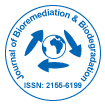Research Article
Bioremediation of Chromium in Pulp and Paper Processing Industrial Effluents by Indigenous Microbes
| Biradar NV1, Sindagi AS2*, Reddy J3 and Ingalhalli SS1 | |
| 1Department of Zoology, Science College, Dharwad -580001, Karnataka, India | |
| 2Department of Microbiology Karnataka Science College, Dharwad -580001, Karnataka, India | |
| 3Department of Botany, Sent Joseph’s Post Graduate and Research Centre, Bangalore-27, Karnataka, India | |
| Corresponding Author : | Sindagi AS Department of Microbiology Karnataka Science College Dharwad -580001, Karnataka, India Tel: 08050423977 E-mail: ambarishimb.s@gmial.com |
| Received November 09, 2012; Accepted November 21, 2012; Published November 23, 2012 | |
| Citation: Biradar NV, Sindagi AS, Reddy J, Ingalhalli SS (2012) Bioremediation of Chromium in Pulp and Paper Processing Industrial Effluents by Indigenous Microbes. J Bioremed Biodeg 3:171. doi: 10.4172/2155-6199.1000171 | |
| Copyright: © 2012 Biradar NV, et al. This is an open-a ccess article distributed under the terms of the Creative Commons Attribution License, which permits unrestricted use, distribution, and reproduction in any medium, provided the original author and source are credited. | |
Related article at Pubmed Pubmed  Scholar Google Scholar Google |
|
Abstract
The present study was conducted with the goal of elimination of chromium toxicity in the pulp and paper processing industrial effluents. The physicochemical analysis of effluents showed that some of the parameters were exceeded and some were within the permissible limits as per the WHO standards. Based on the isolation, identification and biochemical characterization study the isolated strains (P1, P2, P3 and P4) were identified as Lactobacillus sps (P1) and Bacillus sps (P2, P3 and P4) according to Bergy’s Manual of Systematic Bacteriology. The MICs and MBCs study showed that all the bacterial isolates exhibited Cr tolerance for 1 ppm, 2 ppm, 5 ppm and 10 ppm. The bacterial isolates showed very high degree of resistance to the chromium. The growth studies showed that all bacterial strains exposed to high level of the chromium metal concentration in the environment which have adapted to this stress by developing various resistant mechanism. The rate of Cr (VI) reduction increased with decreasing concentration of Cr (VI) and increasing time interval for all the bacteria isolates. All the bacterial isolates showed the best chromate reduction for different concentration of Cr (VI).

 Spanish
Spanish  Chinese
Chinese  Russian
Russian  German
German  French
French  Japanese
Japanese  Portuguese
Portuguese  Hindi
Hindi 
